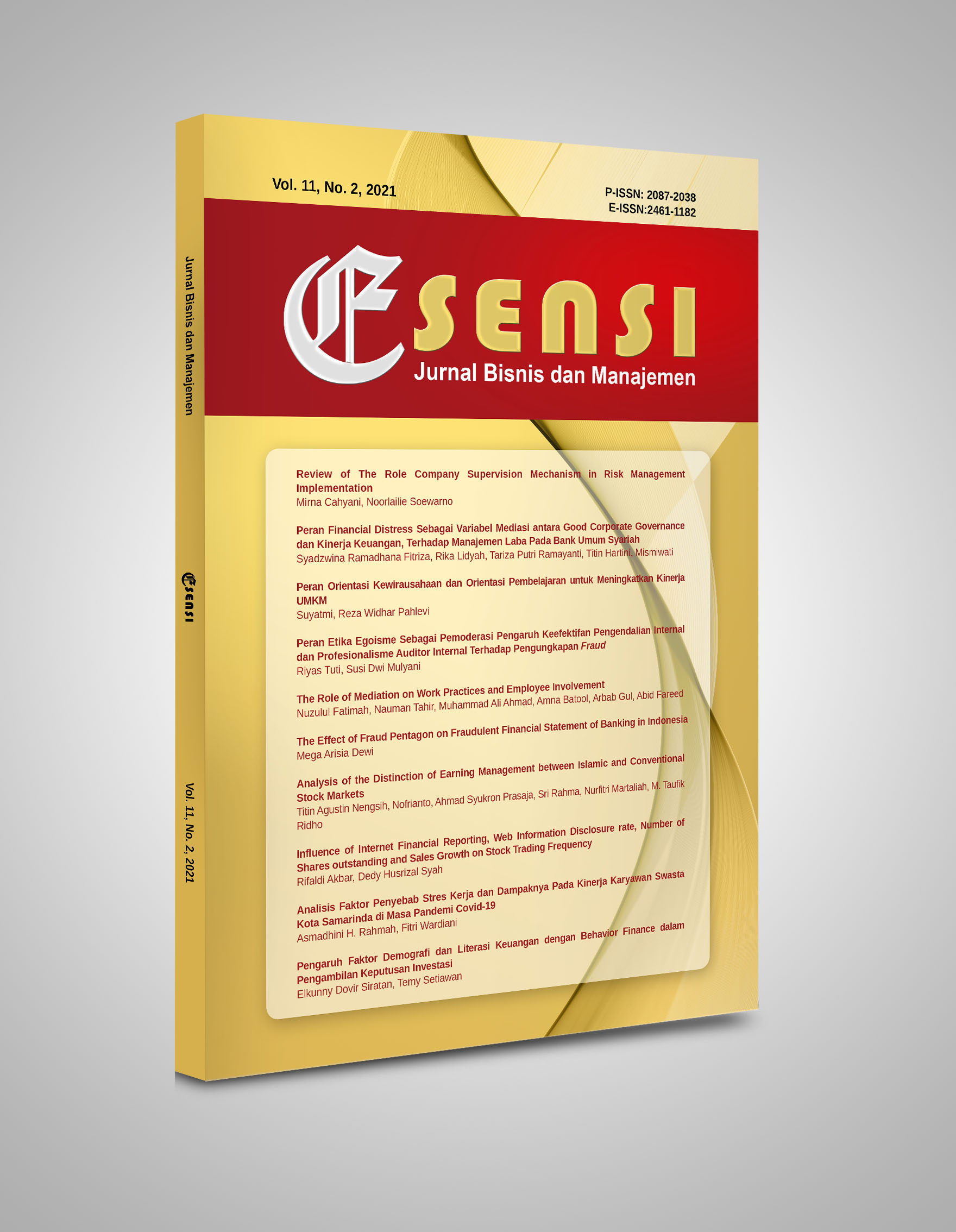The Effect of Fraud Pentagon on Fraudulent Financial Statement of Banking in Indonesia
DOI:
https://doi.org/10.15408/ess.v11i2.23031Keywords:
fraud pentagon, fraudulent financial reportingAbstract
This study aims to determine the effect of financial targets, financial stability, external pressure, effective monitoring, nature of industry, change in auditors, rationalization, change of company directors, CEO’s Picture on fraudulent banking financial statements in Indonesia for 2014-2019. This study uses the dependent variable, namely fraudulent financial reporting, while the independent variables are financial targets, financial stability, external pressure, effective monitoring, nature of industry, change in auditors, rationalization, competence and arrogance. The show that the variable financial targets, change in auditors, change of directors and CEO’s picture have no effect on the detection of fraudulent financial statements. Meanwhile, financial stability, external pressure, ineffective monitoring, nature of industry, and rationalization have an effect on the detection of fraud in financial reports for 2014-2019. The results of this study provide an understanding for the public and the general public that the government’s efforts so far have always played a major role in maintaining the condition of the Indonesian economy in order to avoid attempts to cheat financial statements.References
Agustina, R. D., & Pratomo, D. (2019). Pengaruh fraud pentagon dalam mendeteksi kecurangan pelaporan keuangan. Jurnal Ilmiah MEA (Manajemen, Ekonomi, & Akuntansi), 3(1), 44-62.
Annisya,M., Lindrianasari, dan Asmaranti, Y. (2016). Pendeteksian Kecurangan Laporan Keuangan Menggunakan Fraud Diamond. Jurnal Bisnis dan Manajemen, 23 (1).72-89.
Apriliana, S., & Agustina, L. (2017). The Analysis of Fraudulent Financial Reporting Determinant through Fraud Pentagon Approach. Jurnal Dinamika Akuntansi, 9(2), 154–165. https://doi.org/10.15294/jda.v7i1.4036
Afiah, E. T., & Aulia, V. (2020). Financial Stability, Financial Targets, Effective Monitoring Dan Rationalization Dan Kecurangan Laporan Keuangan. Jurnal Revenue: Jurnal Ilmiah Ilmu Akuntansi, 1(1), 90-100.
Bawekes F. Helda. (2018). Pengujian Fraud Pentagon Terhadap Fraudulent Financial Reporting: Studi Empiris pada Perusahaan yang Terdaftar di BEI Tahun 2011-2015. Jurnal Akuntansi dan Keuangan Daerah Vol. 13 No. 1. Mei 114-134
Beneish, Messod. (1999). The Detection of Earning Manipulation. Financial Analysis Journal. Vol 55, No. 5, p. 1-27.
Crowe, H. (2011). Putting the Freud in Fraud: Why the Fraud Triangle Is No Longer Enough.
IN Howart, Crowe.
Ghozali, I. H. (2016). Aplikasi Analisi Multivariete dengan Program IBM SPSS 23. Edisi 8, Semarang : Universitas Diponegoro.
Indriani, P. (2017). Fraund Diamond Dalam Mendeteksi Kecurangan Laporan Keuangan. I-Finance: a Research Journal on Islamic Finance, 3(2), 161-172.
Husmawati, P., Septriani, Y., Rosita, I., & Handayani, D. (2017). Fraud Pentagon Analysisin Assessing the Likelihood of Fraudulent Financial Statement (Study on Manufacturing Firm Listed in Bursa Efek Indonesia Period 2013-2016). International Conference of Applied Science on Engineering, Business, Linguistic and Information Technology (ICo-ASCNITech), pp: 45-51
Jaya, IMLM dan Ajeng Ayu A. P. (2019). Pengujian Teori Fraud Pentagon Terhadap Kecurangan Laporan Keuangan Pada Perusahaan Pertambangan di Indonesia. Akuntabilitas: Jurnal Ilmu Akuntansi, Vol. 12, Issue 2, Hal.157-168.
Jaya, IMLM. (2019). Metode Penelitian Kuantitatif Dan Kualitatif: Teori, Penerapan, dan Riset Nyata. Volume 1. Yogyakarta: Anak Hebat Indonesia.
Jaya, IMLM dan I Made Narsa. (2020). The Beauty and The Beast Of Earnings Managements In Indonesia, Opcion, Vol. 36 Núm. 91 (2020).
Jensen, M., C., dan W. Meckling, (1976). “Theory of the firm: Managerial behavior, agency cost and ownership structure”, Journal of Finance Economic 3:305- 360, di-download dari http://www.nhh.no/for/courses/spring/eco420/jensenmeckling-76.pdf.
Manurung, Daniel T.H. dan Andhika Ligar Hardika. (2015). Analysis of Factors that Influence Financial Statement Fraud in the Perspective Fraud Diamond : Empirical Study on Banking Companies Listed on the Indonesia Stock Exchange Year 2012 to 2014, International Conference on Accounting Studies.
Mardianto, M., & Tiono, C. (2019). Analisis pengaruh fraud triangle dalam mendeteksi kecurangan laporan keuangan. Jurnal Benefita, 4(1), 87-103.
Marks, J. (2012). The Mind Behind the Fraudsters Crime: Key Behavioral and Environmental Elements. Crowe Horwarth LLP.
Nindito, M. (2018). Financial Statement Fraud: Perspective of the Pentagon Fraud Model in Indonesia. Academy of Accounting and Financial Studies Journal. Vol. 22 Issue 2 pp. 1-9.
Pangesty, S. S., Nuraina, E., & Sulistyowati, N. W. (2018). Pengaruh Fraud Diamond Terhadap Deteksi Kecurangan Laporan Keuangan Pada Perusahaan Manufaktur Yang Terdaftar Di Bei. In FIPA: Forum Ilmiah Pendidikan Akuntansi. 6(2).
Pitaloka, A. P., & Majidah, M. (2019). Analisis Fraud Diamond Dalam Mendeteksi Kecurangan Laporan Keuangan (studi Empiris Pada Perusahaan Manufaktur Yang Terdaftar Pada Bursa Efek Indonesia Periode 2015-2017). eProceedings of Management, 6(1).
Rahmayuni, S. (2018). Analisis Pengaruh Fraud Diamond terhadap Kecurangan Laporan Keuangan (Studi Empiris pada Perusahaan Manufaktur yang Terdaftar di BEI Tahun 2013-2016). Jurnal Akuntansi, 6(1).
Robbins, P.S., & Coutler, M. (2010). Manajemen edisi kesepuluh. Jakarta:Erlangga.
Scott,William R.(2000). Financial Accounting Theory.USA:Prentice-Hall.
Septriani, Yossi, Rosita dan Desi H. (2017). Mendeteksi Kecurangan Laporan Keuangan dengan Analisis Fraud Pentagon. Jurnal Akuntansi, Keuangan dan Bisnis. Vol. 11 No. 1 Mei pp. 11-23.
Septriani, Y., & Handayani, D. (2018). Mendeteksi Kecurangan Laporan Keuangan dengan Analisis Fraud Pentagon. Jurnal Akuntansi Keuangan Dan Bisnis, 11(1), 11-23.
Sihombing, Kennedy S., dan Shiddiq N. R. (2014). Analisis Fraud Diamond dalam Mendeteksi Financial Statement Fraud: Studi Empiris pada Perusahaan Manufaktur yang Terdaftar di Bursa Efek Indonesia (BEI) Tahun 2010-2012. Diponegoro Journal of Accounting. Vol. 03, No. 02, p. 1-12.
Skousen, Christopher J., Kevin R. Smith, dan Charlotte J. Wright. (2009). Detecting and Predicting Financial Statement Fraud: The Effectiveness of the Fraud Triangle and SAS No. 99. Corporate Governance and Firm Performance Advance in Financial Economincs, Vol. 13, p. 53-81.
Subramanyam, KR dan John, J. Wild, (2010). Analisis Laporan Keuangan, Buku Satu, Edisi Sepuluh, Salemba Empat, Jakarta.
Tessa G, Chynthia, dan Puji Harto. (2016). Fraudulent Financial Reporting: Pengujian Teori Fraud Pentagon pada sektor Keuangan dan Perbankan di Indonesia. Simposium Nasional Akuntansi XIX Lampung, p. 1-21.
Yesiariani, M. dan Rahayu, I. (2016). Analisis Fraud Diamond Dalam Mendeteksi Financial Statement Fraud (Studi Empiris Pada Perusahaan LQ-45 Yang Terdaftar Di Burs Efek Indonesia Tahun 2010-2014). Simposium Nasional Akuntansi XIX, 1-22.


